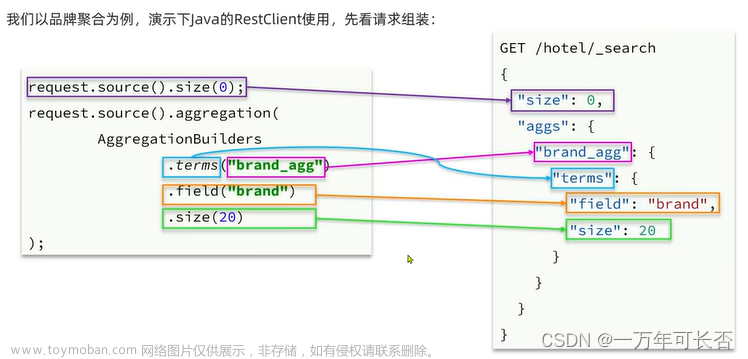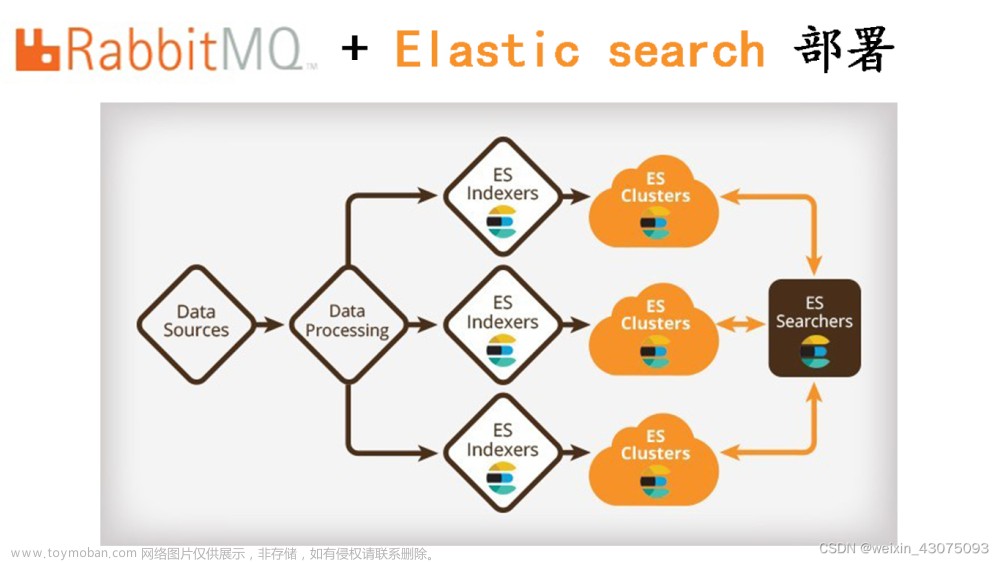1、消息队列概念
1.1 消息队列是什么
消息队列(Message Queue MQ)是实现应用之间数据通信的一种机制,采用先进先出的数据结构和生产者消费者设计模式实现通信。


1.2 消息队列有什么作用
消息队列的优势:
- 解耦
- 异步
- 削峰
1.2.1 解耦
实现生产者和消费者的解耦,生产者和消费者不直接调用,也不用关心对方如何处理,代码的维护性提高
例如:使用openfeign实现服务调用,如果被调用服务的接口发生修改,服务调用方也需要进行修改,服务之间的耦合性较高,不利于开发和维护

1.2.2 异步
同步调用,服务A调用服务B,必须等待服务B执行完业务,服务A才能执行其它业务
异步调用,服务A发送消息给消息队列,马上返回完成其它业务,不用等待服务B执行完

1.2.3 削峰
可以通过控制消息队列的长度来限制请求流量,从而达到限流保护服务器的作用
消息队列的缺点:
- 提高系统的复杂性
- 降低系统的可用性
1.3 主流的消息队列
主流的MQ:
- ActiveMQ
- RabbitMQ
- RocketMQ
- Kafka

1.4 消息队列的基本概念
-
生产者
向消息队列发送消息的服务
-
消费者
从消息队列取消息的服务
-
队列 queue
存放消息的容器,采用FIFO数据结构
-
交换机 exchange
实现消息路由,将消息分发到对应的队列中
-
消息服务器 Broker
进行消息通信的软件平台服务器
-
虚拟主机 virtual host
类似于namespace,将不同用户的交换机和队列区分开来
-
连接 connection
网络连接
-
通道 channel
数据通信的通道

2、安装RabbitMQ
2.1 Linux安装
1)安装erlang
wget https://packages.erlang-solutions.com/erlang-solutions-1.0-1.noarch.rpm
rpm -Uvh erlang-solutions-1.0-1.noarch.rpm
yum install epel-release
yum install erlang
2) 安装rabbitmq 目前的最新版本 支持erlang24
wget https://github.com/rabbitmq/rabbitmq-server/releases/download/v3.9.7/rabbitmq-server-3.9.7-1.el7.noarch.rpm
yum install rabbitmq-server-3.9.7-1.el7.noarch.rpm
3) 启动rabbitmq
service rabbitmq-server start
4) 启用管理工具
rabbitmq-plugins enable rabbitmq_management
5) 防火墙允许端口
firewall-cmd --permanent --add-port=15672/tcp
firewall-cmd --permanent --add-port=5672/tcp
6) 提示不能使用localhost登录,添加远程登录的用户
rabbitmqctl add_user admin admin
rabbitmqctl set_user_tags admin administrator
7) 设置开机启动输入下面命令
chkconfig rabbitmq-server on
2.2 Windows安装
1)下载erlang和RabbitMQ安装包
2)安装erlang
3)安装rabbitmq
4)打开菜单输入命令,启动管理工具
rabbitmq-plugins enable rabbitmq_management
5)启动rabbitMQ
net start rabbitmq
net stop rabbitmq
6)浏览器输入: http://localhost:15672 账号密码都是guest
3、RabbitMQ的基本使用
3.1 添加用户
不同的系统可以使用各自的用户登录RabbitMQ,可以在Admin的User页面添加新用户
3.2 添加虚拟主机
虚拟主机相当于一个独立的MQ服务,有自身的队列、交换机、绑定策略等。
添加虚拟主机
3.2 添加队列
不同的消息队列保存不同类型的消息,如支付消息、秒杀消息、数据同步消息等。
添加队列,需要填写虚拟主机、类型、名称、持久化、自动删除和参数等。
3.3 添加交换机
生产者将消息发送到交换机Exchange,再由交换机路由到一个或多个队列中;
交换器的类型有fanout、direct、topic、headers这四种,下篇文章将详细介绍。
添加交换机
4、RabbitMQ的五种消息模型

RabbitMQ提供了多种消息模型,官网上第6种是RPC不属于常规的消息队列。
属于消息模型的是前5种:
- 简单的一对一模型
- 工作队列模型 ,一个生产者将消息分发给多个消费者
- 发布/订阅模型 ,生产者发布消息,多个消费者同时收取
- 路由模型 ,生产者通过关键字发送消息给特定消费者
- 主题模型 ,路由模式基础上,在关键字里加入了通配符
4.1 一对一模型

最基本的队列模型:
一个生产者发送消息到一个队列,一个消费者从队列中取消息。
4.1.1 操作步骤
1)启动Rabbitmq,在管理页面中创建用户admin
2)使用admin登录,然后创建虚拟主机myhost
创建队列,配置如下
4.1.2 案例代码
导入依赖
<dependency>
<groupId>com.rabbitmq</groupId>
<artifactId>amqp-client</artifactId>
<version>3.4.1</version>
</dependency>
开发工具类
public class MQUtils {
public static final String QUEUE_NAME = "myqueue01";
public static final String QUEUE_NAME2 = "myqueue02";
public static final String EXCHANGE_NAME = "myexchange01";
public static final String EXCHANGE_NAME2 = "myexchange02";
public static final String EXCHANGE_NAME3 = "myexchange03";
/**
* 获得MQ的连接
* @return
* @throws IOException
*/
public static Connection getConnection() throws IOException {
ConnectionFactory connectionFactory = new ConnectionFactory();
//配置服务器名、端口、虚拟主机名、登录账号和密码
connectionFactory.setHost("localhost");
connectionFactory.setPort(5672);
connectionFactory.setVirtualHost("myhost");
connectionFactory.setUsername("admin");
connectionFactory.setPassword("123456");
return connectionFactory.newConnection();
}
}
开发生产者
/**
* 生产者,发送简单的消息到队列中
*/
public class SimpleProducer {
public static void main(String[] args) throws IOException {
Connection connection = MQUtils.getConnection();
//创建通道
Channel channel = connection.createChannel();
//定义队列
channel.queueDeclare(MQUtils.QUEUE_NAME,false,false,false,null);
String msg = "Hello World!";
//发布消息到队列
channel.basicPublish("",MQUtils.QUEUE_NAME,null,msg.getBytes());
channel.close();
connection.close();
}
}
运行生产者代码,管理页面点进myqueue01,在GetMessages中可以看到消息
开发消费者
/**
* 消费者,从队列中读取简单的消息
*/
public class SimpleConsumer {
public static void main(String[] args) throws IOException, InterruptedException {
Connection connection = MQUtils.getConnection();
Channel channel = connection.createChannel();
//定义队列
channel.queueDeclare(MQUtils.QUEUE_NAME,false,false,false,null);
//创建消费者
QueueingConsumer queueingConsumer = new QueueingConsumer(channel);
//消费者消费通道中的消息
channel.basicConsume(MQUtils.QUEUE_NAME,true,queueingConsumer);
//读取消息
while(true){
QueueingConsumer.Delivery delivery = queueingConsumer.nextDelivery();
System.out.println(new String(delivery.getBody()));
}
}
}
4.2 工作队列模型

工作队列,生产者将消息分发给多个消费者,如果生产者生产了100条消息,消费者1消费50条,消费者2消费50条。
4.2.1 案例代码
开发生产者
/**
多对多模式的生产者,会发送多条消息到队列中
*/
public class WorkProductor {
public static void main(String[] args) throws IOException, InterruptedException {
Connection connection = MQUtils.getConnection();
Channel channel = connection.createChannel();
channel.queueDeclare(MQUtils.QUEUE_NAME,false,false,false,null);
for(int i = 0;i < 100;i++){
String msg = "Hello-->" + i;
channel.basicPublish("",MQUtils.QUEUE_NAME,null, msg.getBytes());
System.out.println("send:" + msg);
Thread.sleep(10);
}
channel.close();
connection.close();
}
}
开发消费者1
/**
* 多对多模式的消费者1
*/
public class WorkConsumer01 {
public static void main(String[] args) throws IOException, InterruptedException {
Connection connection = MQUtils.getConnection();
Channel channel = connection.createChannel();
channel.queueDeclare(MQUtils.QUEUE_NAME,false,false,false,null);
QueueingConsumer queueingConsumer = new QueueingConsumer(channel);
//消费者消费通道中的消息
channel.basicConsume(MQUtils.QUEUE_NAME,true,queueingConsumer);
while(true){
QueueingConsumer.Delivery delivery = queueingConsumer.nextDelivery();
System.out.println("WorkConsumer1 receive :" + new String(delivery.getBody()));
Thread.sleep(10);
}
}
}
开发消费者2
/**
* 多对多模式的消费者2
*/
public class WorkConsumer02 {
public static void main(String[] args) throws IOException, InterruptedException {
Connection connection = MQUtils.getConnection();
Channel channel = connection.createChannel();
channel.queueDeclare(MQUtils.QUEUE_NAME,false,false,false,null);
QueueingConsumer queueingConsumer = new QueueingConsumer(channel);
//消费者消费通道中的消息
channel.basicConsume(MQUtils.QUEUE_NAME,true,queueingConsumer);
while(true){
QueueingConsumer.Delivery delivery = queueingConsumer.nextDelivery();
System.out.println("WorkConsumer2 receive :" + new String(delivery.getBody()));
Thread.sleep(1000);
}
}
}
生产者发送100个消息,两个消费者分别读取了50条。
看消息内容,发现队列发送消息采用的是轮询方式,也就是先发给消费者1,再发给消费者2,依次往复。
4.2.2 能者多劳
上面案例中有一个问题:消费者处理消息的速度是不一样的,消费者1处理后睡眠10毫秒(Thread.sleep(10)),消费者2是1000毫秒,速度相差100倍,但是最后处理的消息数还是一样的。这样就存在效率问题:处理能力强的消费者得不到更多的消息。
因为队列默认采用是自动确认机制,消息发过去后就自动确认,队列不清楚每个消息具体什么时间处理完,所以平均分配消息数量。
实现能者多劳:
- channel.basicQos(1);限制队列一次发一个消息给消费者,等消费者有了反馈,再发下一条
- channel.basicAck 消费完消息后手动反馈,处理快的消费者就能处理更多消息
- basicConsume 中的参数改为false
/**
多对多模式的消费者1
*/
public class WorkConsumer1 {
public static void main(String[] args) throws IOException, InterruptedException {
Connection connection = MQUtils.getConnection();
Channel channel = connection.createChannel();
channel.queueDeclare(MQUtils.QUEUE_NAME,false,false,false,null);
//同一时刻服务器只发送一条消息给消费者
channel.basicQos(1);
QueueingConsumer queueingConsumer = new QueueingConsumer(channel);
//true是自动返回完成状态,false表示手动
channel.basicConsume(MQUtils.QUEUE_NAME,false,queueingConsumer);
while(true){
QueueingConsumer.Delivery delivery = queueingConsumer.nextDelivery();
System.out.println("WorkConsumer1 receive :" + new String(delivery.getBody()));
Thread.sleep(10);
//手动确定返回状态,不写就是自动确认
channel.basicAck(delivery.getEnvelope().getDeliveryTag(),false);
}
}
}
/**
* 多对多模式的消费者2
*/
public class WorkConsumer2 {
public static void main(String[] args) throws IOException, InterruptedException {
Connection connection = MQUtils.getConnection();
Channel channel = connection.createChannel();
channel.queueDeclare(MQUtils.QUEUE_NAME,false,false,false,null);
//同一时刻服务器只发送一条消息给消费者
channel.basicQos(1);
QueueingConsumer queueingConsumer = new QueueingConsumer(channel);
//true是自动返回完成状态,false表示手动
channel.basicConsume(MQUtils.QUEUE_NAME,false,queueingConsumer);
while(true){
QueueingConsumer.Delivery delivery = queueingConsumer.nextDelivery();
System.out.println("WorkConsumer2 receive :" + new String(delivery.getBody()));
Thread.sleep(1000);
//手动确定返回状态,不写就是自动确认
channel.basicAck(delivery.getEnvelope().getDeliveryTag(),false);
}
}
}
4.3 发布/订阅模型

发布/订阅模式和Work模式的区别是:Work模式只存在一个队列,多个消费者共同消费一个队列中的消息;而发布订阅模式存在多个队列,不同的消费者可以从各自的队列中处理完全相同的消息。
4.3.1 操作步骤
实现步骤:
- 创建交换机(Exchange)类型是fanout(扇出)
- 交换机需要绑定不同的队列
- 不同的消费者从不同的队列中获得消息
- 生产者发送消息到交换机
- 再由交换机将消息分发到多个队列
新建队列
新建交换机
点击交换机,在bindings里面绑定两个队列
4.3.2 案例代码
生产者
/**
* 发布和订阅模式的生产者,消息会通过交换机发到队列
*/
public class PublishProductor {
public static void main(String[] args) throws IOException {
Connection connection = MQUtils.getConnection();
Channel channel = connection.createChannel();
//声明fanout exchange
channel.exchangeDeclare(MQUtils.EXCHANGE_NAME,"fanout");
String msg = "Hello Fanout";
//发布消息到交换机
channel.basicPublish(MQUtils.EXCHANGE_NAME,"",null,msg.getBytes());
System.out.println("send:" + msg);
channel.close();
connection.close();
}
}
消费者1
/**
* 发布订阅模式的消费者1
* 两个消费者绑定的消息队列不同
* 通过交换机一个消息能被不同队列的两个消费者同时获取
* 一个队列可以有多个消费者,队列中的消息只能被一个消费者获取
*/
public class SubscribeConsumer1 {
public static void main(String[] args) throws IOException, InterruptedException {
Connection connection = MQUtils.getConnection();
Channel channel = connection.createChannel();
channel.queueDeclare(MQUtils.QUEUE_NAME,false,false,false,null);
//绑定队列1到交换机
channel.queueBind(MQUtils.QUEUE_NAME,MQUtils.EXCHANGE_NAME,"");
QueueingConsumer queueingConsumer = new QueueingConsumer(channel);
channel.basicConsume(MQUtils.QUEUE_NAME,true,queueingConsumer);
while(true){
QueueingConsumer.Delivery delivery = queueingConsumer.nextDelivery();
System.out.println("Consumer1 receive :" + new String(delivery.getBody()));
}
}
}
消费者2
public class SubscribeConsumer2 {
public static void main(String[] args) throws IOException, InterruptedException {
Connection connection = MQUtils.getConnection();
Channel channel = connection.createChannel();
channel.queueDeclare(MQUtils.QUEUE_NAME2,false,false,false,null);
//绑定队列2到交换机
channel.queueBind(MQUtils.QUEUE_NAME2,MQUtils.EXCHANGE_NAME,"");
QueueingConsumer queueingConsumer = new QueueingConsumer(channel);
channel.basicConsume(MQUtils.QUEUE_NAME2,true,queueingConsumer);
while(true){
QueueingConsumer.Delivery delivery = queueingConsumer.nextDelivery();
System.out.println("Consumer2 receive :" + new String(delivery.getBody()));
}
}
}
4.4 路由模型

路由模式的消息队列可以给队列绑定不同的key,生产者发送消息时,给消息设置不同的key,这样交换机在分发消息时,可以让消息路由到key匹配的队列中。
可以想象上图是一个日志处理系统,C1可以处理error日志消息,C2可以处理info\error\warining类型的日志消息,使用路由模式就很容易实现了。
4.3.1 操作步骤
新建direct类型的交换机
4.3.2 案例代码
生产者,给myqueue01绑定了key:error,myqueue02绑定了key:debug,然后发送了key:error的消息
/**
路由模式的生产者,发布消息会有特定的Key,消息会被绑定特定Key的消费者获取
*/
public class RouteProductor {
public static void main(String[] args) throws IOException, InterruptedException {
Connection connection = MQUtils.getConnection();
Channel channel = connection.createChannel();
//声明交换机类型为direct
channel.exchangeDeclare(MQUtils.EXCHANGE_NAME2,"direct");
String msg = "Hello-->Route";
//绑定队列1到交换机,指定了Key为error
channel.queueBind(MQUtils.QUEUE_NAME,MQUtils.EXCHANGE_NAME2,"error");
//绑定队列2到交换机,指定了Key为debug
channel.queueBind(MQUtils.QUEUE_NAME2,MQUtils.EXCHANGE_NAME2,"debug");
//error是一个指定的Key
channel.basicPublish(MQUtils.EXCHANGE_NAME2,"error",null,msg.getBytes());
System.out.println("send:" + msg);
channel.close();
connection.close();
}
}
消费者1
/**
* 路由模式的消费者1
* 可以指定Key,消费特定的消息
*/
public class RouteConsumer1 {
public static void main(String[] args) throws IOException, InterruptedException {
Connection connection = MQUtils.getConnection();
Channel channel = connection.createChannel();
channel.queueDeclare(MQUtils.QUEUE_NAME,false,false,false,null);
QueueingConsumer queueingConsumer = new QueueingConsumer(channel);
channel.basicConsume(MQUtils.QUEUE_NAME,true,queueingConsumer);
while(true){
QueueingConsumer.Delivery delivery = queueingConsumer.nextDelivery();
System.out.println("RouteConsumer1 receive :" + new String(delivery.getBody()));
}
}
}
消费者2
/**
* 路由模式的消费者2
* 可以指定Key,消费特定的消息
*/
public class RouteConsumer2 {
public static void main(String[] args) throws IOException, InterruptedException {
Connection connection = MQUtils.getConnection();
Channel channel = connection.createChannel();
channel.queueDeclare(MQUtils.QUEUE_NAME2,false,false,false,null);
QueueingConsumer queueingConsumer = new QueueingConsumer(channel);
channel.basicConsume(MQUtils.QUEUE_NAME2,true,queueingConsumer);
while(true){
QueueingConsumer.Delivery delivery = queueingConsumer.nextDelivery();
System.out.println("RouteConsumer2 receive :" + new String(delivery.getBody()));
}
}
}
4.5 主题模型

主题模式和路由模式差不多,在key中可以加入通配符:
- * 匹配任意一个单词 com.* ----> com.hopu com.blb com.baidu
- # 匹配.号隔开的0个或多个单词 com.# —> com.hopu.net com.hopu com.163.xxx.xxx.xxx
4.3.1 案例代码
生产者代码
/**
主题模式的生产者
*/
public class TopicProductor {
public static void main(String[] args) throws IOException, InterruptedException {
Connection connection = MQUtils.getConnection();
Channel channel = connection.createChannel();
//声明交换机类型为topic
channel.exchangeDeclare(MQUtils.EXCHANGE_NAME3,"topic");
//绑定队列到交换机,最后指定了Key
channel.queueBind(MQUtils.QUEUE_NAME,MQUtils.EXCHANGE_NAME3,"xray.#");
//绑定队列到交换机,最后指定了Key
channel.queueBind(MQUtils.QUEUE_NAME2,MQUtils.EXCHANGE_NAME3,"*.*.cn");
String msg = "Hello-->Topic";
channel.basicPublish(MQUtils.EXCHANGE_NAME3,"rabbit.com.cn",null,msg.getBytes());
System.out.println("send:" + msg);
channel.close();
connection.close();
}
}
消费者1
/**
* 主题模式的消费者1 ,类似路由模式,可以使用通配符对Key进行筛选
* #匹配1个或多个单词,*匹配一个单词
*/
public class TopicConsumer1 {
public static void main(String[] args) throws IOException, InterruptedException {
Connection connection = MQUtils.getConnection();
Channel channel = connection.createChannel();
channel.queueDeclare(MQUtils.QUEUE_NAME,false,false,false,null);
QueueingConsumer queueingConsumer = new QueueingConsumer(channel);
channel.basicConsume(MQUtils.QUEUE_NAME,true,queueingConsumer);
while(true){
QueueingConsumer.Delivery delivery = queueingConsumer.nextDelivery();
System.out.println("TopicConsumer1 receive :" + new String(delivery.getBody()));
}
}
}
消费者2
/**
* 主题模式的消费者2
*/
public class TopicConsumer2 {
public static void main(String[] args) throws IOException, InterruptedException {
Connection connection = MQUtils.getConnection();
Channel channel = connection.createChannel();
channel.queueDeclare(MQUtils.QUEUE_NAME2,false,false,false,null);
QueueingConsumer queueingConsumer = new QueueingConsumer(channel);
channel.basicConsume(MQUtils.QUEUE_NAME2,true,queueingConsumer);
while(true){
QueueingConsumer.Delivery delivery = queueingConsumer.nextDelivery();
System.out.println("TopicConsumer2 receive :" + new String(delivery.getBody()));
}
}
}
5、SpringBoot整合RabbitMQ
1)创建两个SpringBoot项目,一个作为生产者,一个作为消费者
生产者会发送两种消息:保存课程(更新和添加),删除课程
消费者监听两个队列:保存课程队列和删除课程队列
2)给生产者和消费者服务添加依赖
<dependency>
<groupId>org.springframework.boot</groupId>
<artifactId>spring-boot-starter-amqp</artifactId>
</dependency>
3) 给生产者和消费者服务添加配置
spring:
rabbitmq:
host: localhost
port: 5672
username: root
password: 123456
virtual-host: test
4)生产者的配置,用于生成消息队列和交换机
/**
* RabbitMQ的配置
*/
@Configuration
public class RabbitMQConfig {
public static final String QUEUE_COURSE_SAVE = "queue.course.save";
public static final String QUEUE_COURSE_REMOVE = "queue.course.remove";
public static final String KEY_COURSE_SAVE = "key.course.save";
public static final String KEY_COURSE_REMOVE = "key.course.remove";
public static final String COURSE_EXCHANGE = "edu.course.exchange";
@Bean
public Queue queueCourseSave() {
return new Queue(QUEUE_COURSE_SAVE);
}
@Bean
public Queue queueCourseRemove() {
return new Queue(QUEUE_COURSE_REMOVE);
}
@Bean
public TopicExchange topicExchange() {
return new TopicExchange(COURSE_EXCHANGE);
}
@Bean
public Binding bindCourseSave() {
return BindingBuilder.bind(queueCourseSave()).to(topicExchange()).with(KEY_COURSE_SAVE);
}
@Bean
public Binding bindCourseRemove() {
return BindingBuilder.bind(queueCourseRemove()).to(topicExchange()).with(KEY_COURSE_REMOVE);
}
}
5) 生产者发送消息的核心代码
@Resource
private RabbitTemplate rabbitTemplate;
@GetMapping("/course/sendSaveMessage")
public ResponseResult<String> sendSaveMessage() {
//发送消息给队列 1 交换机 2 路由器 3 数据
rabbitTemplate.convertAndSend(RabbitMQConfig.COURSE_EXCHANGE, RabbitMQConfig.COURSE_SAVE_KEY, "添加课程");
return ResponseResult.ok("ok");
}
@GetMapping("/course/sendRemoveMessage")
public ResponseResult<String> sendRemoveMessage() {
//发送消息给队列 1 交换机 2 路由器 3 数据
rabbitTemplate.convertAndSend(RabbitMQConfig.COURSE_EXCHANGE, RabbitMQConfig.COURSE_REMOVE_KEY, 99L);
return ResponseResult.ok("ok");
}
6)消费者添加监听器
import com.blb.common.config.RabbitMQConfig;
import lombok.extern.slf4j.Slf4j;
import org.springframework.amqp.rabbit.annotation.RabbitListener;
import org.springframework.stereotype.Component;
/**
* 课程消息队列监听器
*/
@Slf4j
@Component
public class CourseMQListener {
@RabbitListener(queues = {RabbitMQConfig.COURSE_SAVE_QUEUE})
public void handleSaveCourseMessage(String message) {
log.info("接收到保存课程消息:{}", message);
}
@RabbitListener(queues = {RabbitMQConfig.COURSE_REMOVE_QUEUE})
public void handleRemoveCourseMessage(Long id) {
log.info("接收到删除课程消息:{}", id);
}
注意
- 如果RabbitMQ的服务管理后台未发现我们用代码配置的队列和交换机,可能是未被Spring扫描到,请在消费者和生产者的启动类上添加扫描包的配置(com.blb.common.config包下就是RabbitMQ配置类,放在该包下是为了方便其它服务公用这一配置类)
生产者
@EnableDiscoveryClient
@SpringBootApplication(scanBasePackages = {"com.blb.common.config", "com.blb.educourseservice"})
public class EduCourseServiceApplication {
public static void main(String[] args) {
SpringApplication.run(EduCourseServiceApplication.class, args);
}
}
消费者
@EnableFeignClients(basePackages = "com.blb.edusearchservice.client")
@EnableDiscoveryClient
@SpringBootApplication(scanBasePackages = {"com.blb.common.config", "com.blb.edusearchservice"})
public class EduSearchSearchApplication {
public static void main(String[] args) {
SpringApplication.run(EduSearchSearchApplication.class, args);
}
}
6 总结
一、消息队列是分布式系统的重要组件,起到的作用有:
- 解耦,生产者和消费者不需要知道对方的具体接口
- 异步,生产者发送完消息直接结束,不需要等待消费者执行完,效率高
- 削峰,控制高峰期消息的数量,降低服务器压力
二、RabbitMQ的消息模型有:
-
一对一,一个生产者一个队列一个消费者,一个发一个收
-
一对多,一个生产者一个队列多个消费者,多个消费者共享一个队列中的消息
-
发布订阅模式
由交换机绑定多个队列,消息分发到多个队列,每个消费者消费自己的队列中的消息
-
路由模式
在发布订阅模式的基础上,加入路由键,消息通过键路由到不同的队列
-
主题模式文章来源:https://www.toymoban.com/news/detail-801850.html
在路由模式基础上,键中加入通配符,实现更加灵活的匹配文章来源地址https://www.toymoban.com/news/detail-801850.html
到了这里,关于带你深入了解RabbitMQ的文章就介绍完了。如果您还想了解更多内容,请在右上角搜索TOY模板网以前的文章或继续浏览下面的相关文章,希望大家以后多多支持TOY模板网!












